When did the first people reach the Americas? Clues are extremely rare. For decades, researchers believed it was the Clovis culture, first identified near Clovis, New Mexico. As early as roughly 14,000 years ago, the first explorers were thought to have crossed the Bering Land Bridge, traveled through an ice-free corridor in the central part of North America, and then spread outward. Distinctively fluted Clovis projectile points, together with bone and ivory tools, are found in hundreds of archaeological sites in North America. Then, in 2021, human footprints found in White Sands National Park, New Mexico were associated with astonishingly early age dates, indicating these footprints are several thousand years older than Clovis artifacts. Late in 2023, researchers have given us new and rock-solid age estimates—data that will require fundamental changes in rewriting our history. It is a paradigm shift.
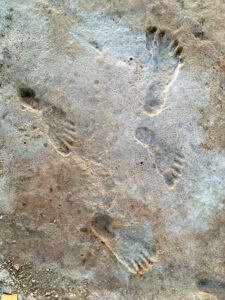
White Sands footprints that vary in size and direction, suggesting that there were multiple individuals present around the same time (Wikimedia)
The new research is published in the October 5, 2023, issue of Science. In short, researchers have used two independent age dating techniques that corroborate a third technique to show that the footprints are between 23,000 and 21,000 years old. The convergence of results from three different dating techniques provides exceptionally solid information.
Controversy around these dates is likely to continue, as past examples of ground-breaking archaeological research have illustrated. I share one now-classic story below, but first some information about the new data from White Sands.
New Age Dates from White Sands
Footprints left as impressions in soft sand or mud that later hardens into solid rock are tremendously valuable in understanding the history of life on our planet. Many regions on Earth today contain fossil footprints, especially those with arid climates where details can be exposed for longer before they are destroyed by weathering.
The arid desert landscape of White Sands National Park is renowned for fossil footprints—especially for now-extinct mammoths, camels, saber-tooth cats, and other large mammals. In addition, in 2009, hundreds of human footprints were discovered. Researchers used radiocarbon age dating on seeds of an aquatic plant called spiral ditchgrass (Ruppia cirrhosa) that are associated with the footprints, and these revealed the surprisingly early result of between 23,000 and 21,000 years old. I describe some trackways, and this age dating analysis in my December 2021 post, here: Following Fossil Footprints—Part 2.
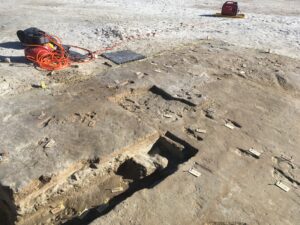
Dozens of footprints marked at different stratigraphic levels using numbered tags (Wikimedia)
A key tenet of science is that reproducible results are required. Some experts viewed the original age estimates of the White Sands footprints with skepticism. The ditchgrass plants could have possibly taken up carbon from groundwater, or surface water in contact with bedrock, which might give erroneously old dates.
Accordingly, researchers returned to the site to obtain additional age data in the same stratigraphic horizons as the footprints and ditchgrass seeds. This time, they patiently collected thousands of pollen grains from fir, spruce and pine. They also obtained optically stimulated luminescence data—an age dating technique that shows the last time quartz grains were exposed to sunlight. The pollen ages are statistically identical to the corresponding seed ages—and the quartz samples give a minimum age of about 21,500 years. Taken together, the three techniques provide powerful support for the 23,000-to-21,000-year age range of these human footprints. Fascinating!
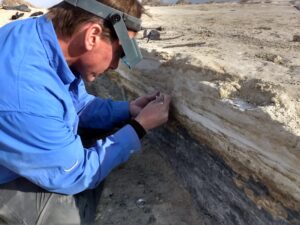
Principal investigator Jeff Pigati, a geologist with the USGS, examining the seeds found in a sedimentary layer near the footprints (Wikimedia)
The Great Antiquity of Monte Verde, Southern Chile
Archaeologists have found accurately dated human occupation sites near the southern tip of the South America continent that are several thousand years older than the Clovis culture. There is especially convincing evidence at the Monte Verde site in southern Chile, which contains a treasure trove of remarkably well-preserved ancient artifacts. Wooden corner posts that supported huts, scraps of animal hides used for clothing and bedding, many wood and stone tools, and hearths with scattered berries and seeds are among the artifacts recovered.
Fortuitously, a swampy bog developed over this ancient settlement site shortly after abandonment by the inhabitants, and the anaerobic conditions inhibited organic matter decay, creating optimal preservation conditions. Multiple lines of evidence show occupation by hunter-gatherer people at least 18,500 to 14,500 years ago, and possibly even earlier.
The first archaeological excavations at Monte Verde began in 1977 under the direction of anthropologist Tom Dillehay. When radiocarbon age dating indicated the great antiquity of the site, many archaeologists and anthropologists reacted with outrage and disbelief. Surely, they insisted, the Clovis culture that is securely and consistently dated at numerous sites represented the earliest migrations into the Americans! And surely, the early dates from Monte Verde must be erroneous! In a publication Tom Dillehay wrote in 1997, titled “The Battle of Monte Verde,” he notes the disagreements had become so emotionally charged that one archaeologist likened it to the debate between creationists and evolutionists. (Yikes!)
Forty years, and multiple age-dating analyses later, the great antiquity of the Monte Verde site is confirmed. Most researchers now accept that Clovis culture people appeared on the scene relatively late in the migration story of the Americas. Updating long-held beliefs can take time.
Looking Both Backward and Forward
The three independent age dating techniques used for the human footprints at White Sands provide a major leap forward in our understanding of when the earliest people reached the Americas. There were many obstacles along the paths they would have traveled. Some information about this is in my post here: The Kelp Highway.
Tracing the migration history of the first Americans into South America is a topic I include in my soon-to-be-published book (working title: The Monumental Andes: Geology, Geography, and Ancient Cultures in the Peruvian Andes.) When that book becomes available—hopefully in Spring 2024—readers can find more about this intriguing story. And we can be confident that researchers will continue to discover new and exciting details about the human history of the Americas.
If you liked this post, please share it and/or leave a comment or question below and I will reply – thanks! And if you’d like to receive a message when I publish a new post, scroll down to the bottom of this page, and leave your email address on my website. Join now to learn more about geology, geography, culture, and history.
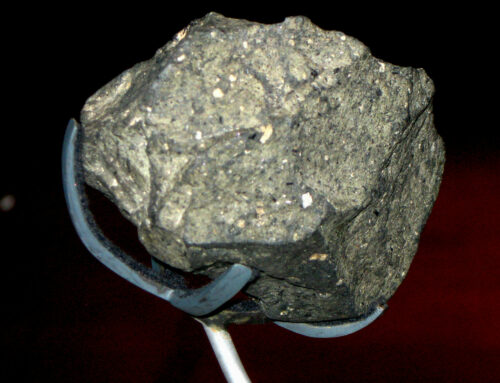
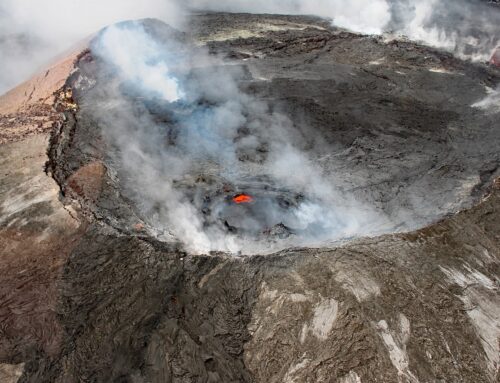
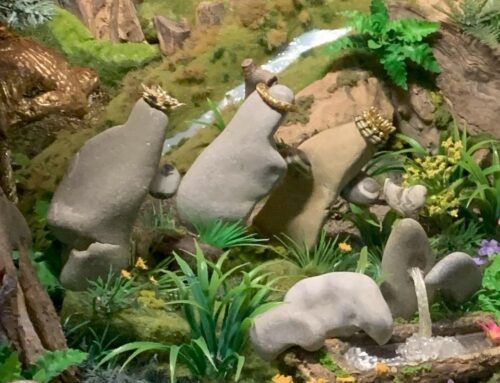

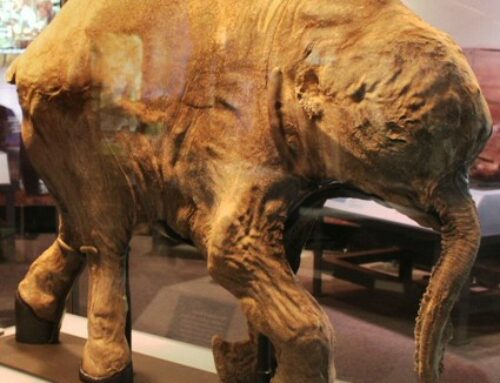
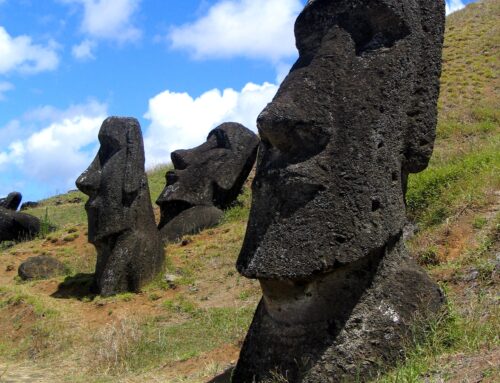
I will go step in mud, and cover it with layers of moss, to ensure my presence on earth is well noted.
Good idea, Joey! Although covering your footprints with sand (and writing your name in them) might be a better way to identify them for future generations!
I had the privilege of visiting the Laetoli footprints in Tanzania some two years ago – during the pandemic. I had the place all to myself! These footprints have been dated as being 3.6 million years old. They are in remarkably good shape, and seem similar in quality to those you describe in your article.
The hominids at Laetoli were already walking upright by then, and they seem to show a male, a female and a child, perhaps walking to fetch water or returning home. But they seem to tell us something more: 3.6Ma our ancestors already had the same concept that we have today of family.
My interest in paleontology has taken me to geology. It seems that as a geologist you are headed in the opposite direction!
Both fields complement each other greatly. Thanks and can’t wait for your book!
Thanks, Leo! How wonderful that you were in Tanzania and saw the amazingly ancient Laetoli footprints!
My fascination with geology is closely followed by interests in paleontology and archaeology. Happily, my blog presents opportunities to research and write about topics that span all these fields. I appreciate your comments and interest in my book — thank you!
This is fascinating! I remember messaging you about the footprints in 2021, and you warned me about the need for supportive dating information. Got it! Thanks Roseanne.
Thanks, Steve! Yes — it is remarkable to now have three independent techniques that converge on the same extremely ancient age dates!
Another fascinating treatise on mankind’s earlier and vast peregrinations, Roseanne. Hope the progress of your book is coming along.
Thank you, Karen! Book is in the hands of the production team and should be available in Spring 2024.